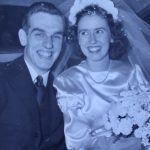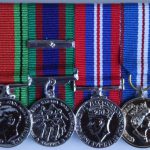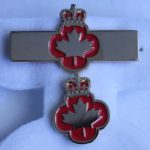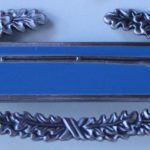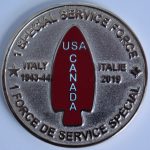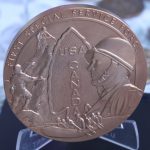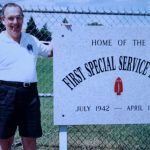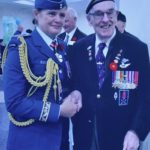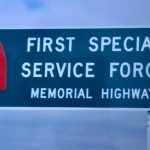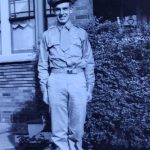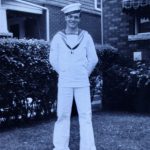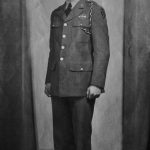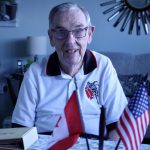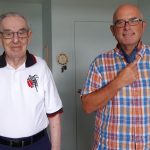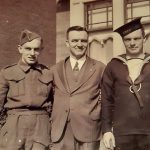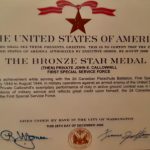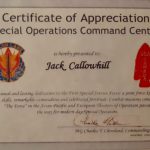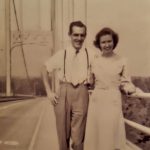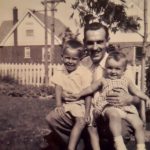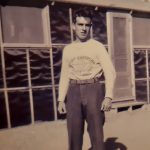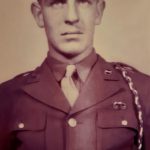Jack Callowhill was born in Hamilton, Ontario on April 13, 1923. He grew up in that industrial city against the backdrop of the Great Depression, where he attended school and choir, and was as well a “Saturday Night Soldier” in the reserves. That saw him sent off to Valcartier Camp in Quebec at the outset of the war, which was not a place he wanted to be. Jack found the routine there to be monotonous, so when a special notice went up – looking for volunteers for a special unit – he volunteered. Soon he was on a train, bound for Montana. Jack would now be working and training to secure his place in an elite American-Canadian unit, which came to be known as the First Special Services Force (FSSF). Jack recalls that the training was intense; the men did parachute jump training, along with hand-to-hand combat, amphibious landings, and demolitions instruction. After Helena the men made their way to Virginia and Vermont to finalize their training, and they were bound overseas. It was at this point that the direction of travel surprised the men: they were put on a train and sent west to San Francisco. A deployment in the Pacific was not out of the question, but then they started to head north, learning that their first operation was to take place in Alaska. Their mission was to defeat the Japanese forces in the Aleutians, and to push them off American soil. Jack’s regiment went ashore in Amchitka, and they were tasked with building a runway for faster aerial deployments, while other elements of the FSSF were moved into combat positions on other islands. As it happened, much of the Japanese force had withdrawn before their arrival, so the operation proved to be anticlimactic. The request that was about to come from General Eisenhower would prove to be their real test. The men headed south and east at his behest, and were quickly on their way across the Atlantic, heading for the fight in the Mediterranean. They first stopped in Casablanca, which Jack recalls as a totally new world, and there they were put in boxcars and sent to Oran, and from there they again boarded ships bound for Italy. The first stop was Naples, but the real destination was the Liri Valley and la Difensa, the mountain where the FSSF would really prove its mettle. All of their training, skill, and fitness would be put to the test as the FSSF pushed the Germans off the mountain. Jack was hit by mortar fire in the aftermath of the initial assault; grievously wounded, the other men somehow got him down the mountain, which Jack does not remember. He ended up in Naples, and then at a hospital near Tunis; his recovery took months, and then it became a matter of where to send him, as no Canadian units were in the area. Jack made his way back to Naples, where he witnessed the eruption of Vesuvius, and then onto Santa Maria Infante, where he became a weapons instructor. Not long after Jack met up with other men of the FSSF, and he hoped to rejoin the unit, but a doctor dashed those hopes, saying Jack was medically unfit. Reconnecting with the FSSF did secure his passage back to England, where he found himself in a Repat Depot, waiting for the return to Canada. He celebrated VE Day on the streets of London, and managed to visit his brother’s grave in Ireland, having learned of his death many months after the event. Finally he boarded the Queen Elizabeth, bound for home; back in Hamilton, Jack went to work, and reconnected with a young woman in the church choir, Donna Jean. They married and raised their family, settling into the rhythms of postwar Canadian life. Jack was interviewed for the Crestwood Oral History Project by Scott Masters, who visited him in Hamilton in August 2020.
Videos
Click next video below to keep watching
- 1. Early Life in Hamilton; Joining Up
- 2. Training; On to Montana
- 3. Canadians and Americans; Helena
- 4. Vermont and California
- 5. The Aleutians; Back to the East Coast
- 6. Crossing the Atlantic; North Africa and Italy
- 7. Going into Action in Italy
- 8. Jack and Clyde
- 9. North Africa and Vesuvius
- 10. England; VE Day
- 11. Recovery
- 12. Return to Canada; Reunions and Remembrance
